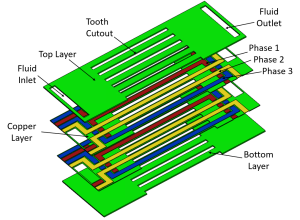Electric Machines with Dielectric Microfluidic Cooling of Planar Windings
PhD Student: Daniel Moguel (ME) Steve Pekarek (Professor of ECE), Justin Weibel (Associate Professor of ME)
Increasing the current density of windings is a means to increase the torque density, and thus the power density, of an electric machine. Recent demonstrations of planar inductors within printed circuit boards (PCB) [[1]] have demonstrated high coil current densities that exceed those achievable in traditional power-dense machinery (~30 A/mm2), which are held back due to winding temperatures. This requires innovation in thermal management strategies and motivates to our ongoing approach to leverage microgap cooling between the boards using a dielectric fluid within stator slots as both a coolant and an insulator. This has the potential to altogether bypasses the thermal resistance associated with conduction through solid insulators, allowing high current densities at reasonable winding temperatures. We have finalized the prototype design of such a PCB-based winding with embedded cooling as illustrated in Figure 31a. Fluid enters the PCB stack from an inlet, is distributed through channels and directly passes over the planar windings before exiting. While this design is shown with two internal PCB layers with each phase as indicated, the design allows for stacking of many such internal layers to increase the copper fill ratio. This PCB stack has cutouts to fit over the stator teeth and slot into the stator as shown in Figure 31b, also showcasing multiple such stacks inserted around the circumference of the stator.
The specific accomplishments to date include the finalization of the PCB-based winding design as shown in Figure 31, with specific considerations for compatibility with high-volume manufacturing techniques used in standard PCBs. A thermal model has been developed to predict temperatures of dielectric fluid and copper windings, and a hydraulic model to predict the pressure drop across the channels. These models have been used to design the parameters of the PCB and ensure that the windings are at reasonable temperatures at a target current density of 50 A/mm2. Combining the concept design with the thermal model results, a fully parameterized CAD model was developed that allows for the PCB stack to be automatically resized to accommodation any given machine design parameters (e.g., the stator length, slot/tooth dimensions, etc.). Combining these assets and targeting a baseline machine design, a physical prototype of the PCB stack has been fabricated. A facility has also been configured to test the prototype by passing through a dielectric fluid under high-current-density operation of the windings, with testing as the next immediate objective. The PCB-based windings and embedded cooling described, along with the development of a modeling framework that can allow for rigorous multi-objective co-optimization, provide the opportunity for significant increases in torque density levels in electric drive systems.

